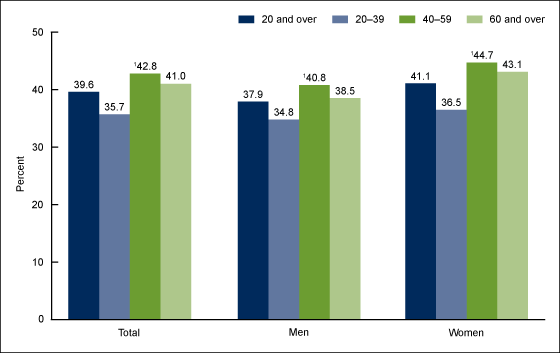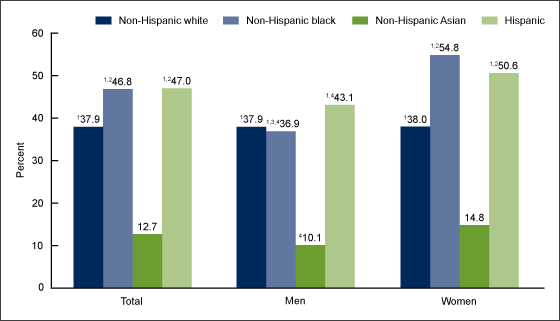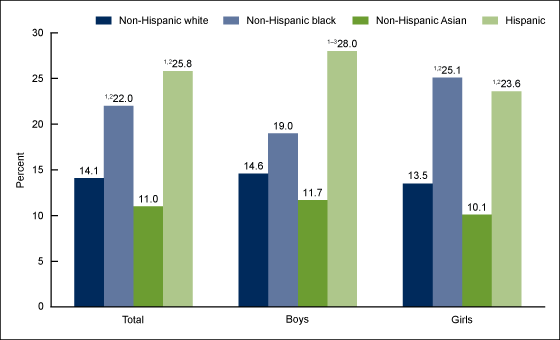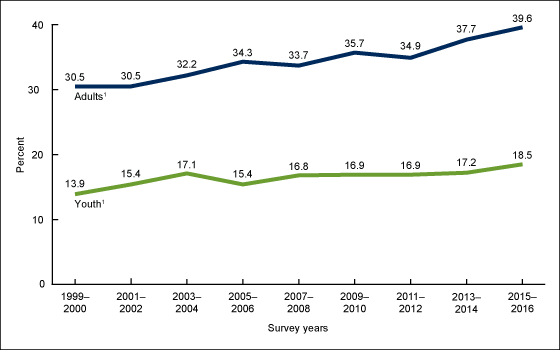Prevalence of Obesity Among Adults and Youth: United States, 2015–2016
On This Page
- Key findings
- What was the prevalence of obesity in adults in 2015–2016?
- Were there differences in the prevalence of obesity among adults by race and Hispanic origin in 2015–2016?
- What was the prevalence of obesity among youth aged 2–19 years in 2015–2016?
- Were there differences in the prevalence of obesity among youth aged 2–19 years by race and Hispanic origin in 2015–2016?
- What are the trends in adult and childhood obesity?
- Summary
- Definition
- Data source and methods
- About the authors
- References
- Suggested citation
NCHS Data Brief No. 288, October 2017
PDF Version (589 KB)
Craig M. Hales, M.D., Margaret D. Carroll, M.S.P.H., Cheryl D. Fryar, M.S.P.H., and Cynthia L. Ogden, Ph.D.
Key findings
Data from the National Health and Nutrition Examination Survey
- In 2015–2016, the prevalence of obesity was 39.8% in adults and 18.5% in youth.
- The prevalence of obesity was higher among middle-aged adults (42.8%) than among younger adults (35.7%).
- The prevalence of obesity was higher among youth aged 6–11 years (18.4%) and adolescents aged 12–19 years (20.6%) compared with children aged 2–5 years (13.9%).
- The overall prevalence of obesity was higher among non-Hispanic black and Hispanic adults than among non-Hispanic white and non-Hispanic Asian adults. The same pattern was seen among youth.
- The observed change in prevalence between 2013–2014 and 2015–2016 was not significant among both adults and youth.
Obesity is associated with serious health risks (1). Monitoring obesity prevalence is relevant for public health programs that focus on reducing or preventing obesity. Between 2003–2004 and 2013–2014, there were no significant changes in childhood obesity prevalence, but adults showed an increasing trend (2). This report provides the most recent national estimates from 2015–2016 on obesity prevalence by sex, age, and race and Hispanic origin, and overall estimates from 1999–2000 through 2015–2016.
Keyword: National Health and Nutrition Examination Survey
What was the prevalence of obesity in adults in 2015–2016?
The prevalence of obesity among U.S. adults was 39.8% (crude). Overall, the prevalence among adults aged 40–59 (42.8%) was higher than among adults aged 20–39 (35.7%). No significant difference in prevalence was seen between adults aged 60 and over (41.0%) and younger age groups (Figure 1).
Among both men and women, the prevalence of obesity followed a similar pattern by age. Men aged 40–59 (40.8%) had a higher prevalence of obesity than men aged 20–39 (34.8%). Women aged 40–59 (44.7%) had a higher prevalence of obesity than women aged 20–39 (36.5%). For both men and women, the prevalence of obesity among those aged 60 and over was not significantly different from the prevalence among those aged 20–39 or 40–59.
There was no significant difference in the prevalence of obesity between men and women overall or by age group.
Figure 1. Prevalence of obesity among adults aged 20 and over, by sex and age: United States, 2015–2016
1Significantly different from those aged 20–39.
NOTES: Estimates for adults aged 20 and over were age adjusted by the direct method to the 2000 U.S. census population using the age groups 20–39, 40–59, and 60 and over. Crude estimates are 39.8% for total, 38.0% for men, and 41.5% for women. Access data table for Figure 1.
SOURCE: NCHS, National Health and Nutrition Examination Survey, 2015–2016.
Were there differences in the prevalence of obesity among adults by race and Hispanic origin in 2015–2016?
The prevalence of obesity was lower among non-Hispanic Asian adults (12.7%) compared with all other race and Hispanic-origin groups. Hispanic (47.0%) and non-Hispanic black (46.8%) adults had a higher prevalence of obesity than non-Hispanic white adults (37.9%). The pattern among women was similar to the pattern in the overall adult population. The prevalence of obesity was 38.0% in non-Hispanic white, 54.8% in non-Hispanic black, 14.8% in non-Hispanic Asian, and 50.6% in Hispanic women. Among men, the prevalence of obesity was lower in non-Hispanic Asian adults (10.1%) compared with non-Hispanic white (37.9%), non-Hispanic black (36.9%), and Hispanic (43.1%) men. Non-Hispanic black men had a lower prevalence of obesity than Hispanic men, but there was no significant difference between non-Hispanic black and non-Hispanic white men (Figure 2).
Among non-Hispanic black, non-Hispanic Asian, and Hispanic adults, women had a higher prevalence of obesity than men. There was no significant difference in prevalence between non-Hispanic white men and women.
Figure 2. Age-adjusted prevalence of obesity among adults aged 20 and over, by sex and race and Hispanic origin: United States, 2015–2016
1Significantly different from non-Hispanic Asian persons.
2Significantly different from non-Hispanic white persons.
3Significantly different from Hispanic persons.
4Significantly different from women of same race and Hispanic origin.
NOTES: All estimates are age adjusted by the direct method to the 2000 U.S. census population using the age groups 20–39, 40–59, and 60 and over. Access data table for Figure 2.
SOURCE: NCHS, National Health and Nutrition Examination Survey, 2015–2016.
What was the prevalence of obesity among youth aged 2–19 years in 2015–2016?
The prevalence of obesity among U.S. youth was 18.5% in 2015–2016. Overall, the prevalence of obesity among adolescents (12–19 years) (20.6%) and school-aged children (6–11 years) (18.4%) was higher than among preschool-aged children (2–5 years) (13.9%). School-aged boys (20.4%) had a higher prevalence of obesity than preschool-aged boys (14.3%). Adolescent girls (20.9%) had a higher prevalence of obesity than preschool-aged girls (13.5%) (Figure 3).
There was no significant difference in the prevalence of obesity between boys and girls overall or by age group.
Figure 3. Prevalence of obesity among youth aged 2–19 years, by sex and age: United States, 2015–2016
1Significantly different from those aged 2–5 years.
NOTE: Access data table for Figure 3.
SOURCE: NCHS, National Health and Nutrition Examination Survey, 2015–2016.
Were there differences in the prevalence of obesity among youth aged 2–19 years by race and Hispanic origin in 2015–2016?
The prevalence of obesity among non-Hispanic black (22.0%) and Hispanic (25.8%) youth was higher than among both non-Hispanic white (14.1%) and non-Hispanic Asian (11.0%) youth. There were no significant differences in the prevalence of obesity between non-Hispanic white and non-Hispanic Asian youth or between non-Hispanic black and Hispanic youth. The pattern among girls was similar to the pattern in all youth. The prevalence of obesity was 25.1% in non-Hispanic black, 23.6% in Hispanic, 13.5% in non-Hispanic white, and 10.1% in non-Hispanic Asian girls. The pattern among boys was similar to the pattern in all youth, except Hispanic boys (28.0%) had a higher prevalence of obesity than non-Hispanic black boys (19.0%) (Figure 4).
There were no significant differences in the prevalence of obesity between boys and girls by race and Hispanic origin.
Figure 4. Prevalence of obesity among youth aged 2–19 years, by sex and race and Hispanic origin: United States, 2015–2016
1Significantly different from non-Hispanic Asian persons.
2Significantly different from non-Hispanic white persons.
3Significantly different from non-Hispanic black persons.
NOTE: Access data table for Figure 4.
SOURCE: NCHS, National Health and Nutrition Examination Survey, 2015–2016.
What are the trends in adult and childhood obesity?
From 1999–2000 through 2015–2016, a significantly increasing trend in obesity was observed in both adults and youth. The observed change in prevalence between 2013–2014 and 2015–2016, however, was not significant among both adults and youth (Figure 5).
Figure 5. Trends in obesity prevalence among adults aged 20 and over (age adjusted) and youth aged 2–19 years: United States, 1999–2000 through 2015–2016
1Significant increasing linear trend from 1999–2000 through 2015–2016.
NOTES: All estimates for adults are age adjusted by the direct method to the 2000 U.S. census population using the age groups 20–39, 40–59, and 60 and over. Access data table for Figure 5.
SOURCE: NCHS, National Health and Nutrition Examination Survey, 1999–2016.
Summary
The prevalence of obesity was 39.8% among adults and 18.5% among youth in the United States in 2015–2016. The prevalence of obesity was higher among adults aged 40–59 than among adults aged 20–39 overall and in both men and women. Among youth, the prevalence of obesity among those aged 2–5 years was lower compared with older children, and this pattern was seen in both boys and girls.
Women had a higher prevalence of obesity than men among non-Hispanic black, non-Hispanic Asian, and Hispanic adults, but not among non-Hispanic white adults. Among youth, there was no significant difference in obesity prevalence between boys and girls of the same race and Hispanic origin.
Overall, non-Hispanic black and Hispanic adults and youth had a higher prevalence of obesity compared with other race and Hispanic-origin groups. Obesity prevalence was lower among non-Hispanic Asian men and women compared with other race and Hispanic-origin groups. Among men, obesity prevalence was similar between non-Hispanic black and non-Hispanic white men, but obesity prevalence was higher among Hispanic men compared with non-Hispanic black men. For women, obesity prevalence was similar among non-Hispanic black and Hispanic women, and both groups had a higher prevalence of obesity than non-Hispanic white women. Among youth, obesity prevalence among non-Hispanic black and Hispanic youth was higher than both non-Hispanic white and non-Hispanic Asian youth. This pattern was similar among boys and girls, except Hispanic boys had a higher obesity prevalence than non-Hispanic black boys.
Obesity prevalence increased in both adults and youth during the 18 years between 1999–2000 and 2015–2016. Previous analyses showed no change in prevalence among youth between 2003–2004 and 2013–2014 (2). In addition, the observed increase in prevalence between 2013–2014 and 2015–2016 was not significant among youth or adults.
Obesity is defined using cut points of body mass index (BMI). BMI does not measure body fat directly, and the relationship between BMI and body fat varies by sex, age, and race and Hispanic origin (3,4). Morbidity and mortality risk may vary between different race and Hispanic-origin groups at the same BMI. Among some Asian subgroups, risk may begin to increase at a lower BMI compared with other race and Hispanic-origin groups, although study results have varied (5,6).
The definition of obesity is based on BMI for both youth and adults, but the definitions are not directly comparable. Among adults, there is a set cut point based on health risk, while among children, the definition is statistical and is based on a comparison to a reference population (7).
The prevalence of obesity in the United States remains higher than the Healthy People 2020 goals of 14.5% among youth and 30.5% among adults (8).
Definition
Obesity: BMI was calculated as weight in kilograms divided by height in meters squared, rounded to one decimal place. Obesity in adults was defined as a BMI of greater than or equal to 30. Obesity in youth was defined as a BMI of greater than or equal to the age- and sex-specific 95th percentile of the 2000 Centers for Disease Control and Prevention growth charts (7).
Data source and methods
Data from nine 2-year cycles of the National Health and Nutrition Examination Surveys (NHANES) (1999–2000, 2001–2002, 2003–2004, 2005–2006, 2007–2008, 2009–2010, 2011–2012, 2013–2014, and 2015–2016) were used for these analyses. Data from NHANES 2015–2016 were used to test differences between subgroups. This 2-year NHANES survey cycle provides the most recent estimates of obesity. However, the precision of the estimated prevalence of obesity and the ability to detect differences in the prevalence when a difference does exist are lower than when estimates are based on 4 years of data because of the smaller sample sizes. In testing for trends in obesity, orthogonal contrasts were used with the nine 2-year cycles.
NHANES is a cross-sectional survey designed to monitor the health and nutritional status of the civilian noninstitutionalized U.S. population (9). The survey consists of interviews conducted in participants’ homes and standardized physical examinations, including measured height and weight, in mobile examination centers.
The NHANES sample is selected through a complex, multistage probability design. Starting in 2011, non-Hispanic black, non-Hispanic Asian, and Hispanic persons, among other groups, were oversampled to obtain reliable estimates for these population subgroups. Race- and Hispanic origin-specific estimates reflect individuals reporting only one race; those reporting more than one race are included in the total but are not reported separately.
Examination sample weights, which account for the differential probabilities of selection, nonresponse, and noncoverage, were incorporated into the estimation process. All variance estimates accounted for the complex survey design by using Taylor series linearization. Pregnant females were excluded from analyses.
Prevalence estimates for the adult population aged 20 and over were age adjusted using the direct method to the 2000 projected U.S. census population using the age groups 20–39, 40–59, and 60 and over. Differences between groups were tested using a univariate t statistic at the p < 0.05 significance level. All differences reported are statistically significant unless otherwise indicated. Adjustments were not made for multiple comparisons. Data management and statistical analyses were conducted using SAS System for Windows version 9.4 (SAS Institute, Inc., Cary, N.C.), SUDAAN version 11.0 (RTI International, Research Triangle Park, N.C.), and R version 3.4.1 (R Foundation for Statistical Computing, Vienna, Austria), including the R survey package (10) to account for the complex sample design.
About the authors
Craig M. Hales, Margaret D. Carroll, Cheryl D. Fryar, and Cynthia L. Ogden are with the National Center for Health Statistics, Division of Health and Nutrition Examination Surveys.
References
- National Institutes of Health. National Heart, Lung, and Blood Institute. Clinical guidelines on the identification, evaluation, and treatment of overweight and obesity in adults—The evidence report. Obes Res 6(Suppl 2):51S–209S. 1998.
- Ogden CL, Carroll MD, Fryar CD, Flegal KM. Prevalence of obesity among adults and youth: United States, 2011–2014. NCHS data brief, no 219. Hyattsville, MD: National Center for Health Statistics. 2015.
- Flegal KM, Ogden CL, Yanovski JA, Freedman DS, Shepherd JA, Graubard BI, Borrud LG. High adiposity and high body mass index-for-age in U.S. children and adolescents overall and by race-ethnic group. Am J Clin Nutr 91(4):1020–6. 2010.
- Deurenberg P, Deurenberg-Yap M, Guricci S. Asians are different from Caucasians and from each other in their body mass index/body fat per cent relationship. Obes Rev 3(3):141–6. 2002.
- Jafar TH, Islam M, Poulter N, Hatcher J, Schmid CH, Levey AS, Chaturvedi N. Children in South Asia have higher body mass-adjusted blood pressure levels than white children in the United States: A comparative study. Circulation 111(10):1291–7. 2005.
- Zheng W, McLerran DF, Rolland B, Zhang X, Inoue M, Matsuo K, et al. Association between body-mass index and risk of death in more than 1 million Asians. N Engl J Med 364(8):719–29. 2011.
- Ogden CL, Flegal KM. Changes in terminology for childhood overweight and obesity. National health statistics reports; no 25. Hyattsville, MD: National Center for Health Statistics. 2010.
- U.S. Department of Health and Human Services. Office of Disease Prevention and Health Promotion. Healthy People 2020 Topics & Objectives: Nutrition and weight status.
- Johnson CL, Dohrmann SM, Burt VL, Mohadjer LK. National Health and Nutrition Examination Survey: Sample design, 2011–2014. National Center for Health Statistics. Vital Health Stat 2(162). 2014.
- Lumley T. Survey: Analysis of complex survey samples. R package (Version 3.32) [computer program]. 2017.
Suggested citation
Hales CM, Carroll MD, Fryar CD, Ogden CL. Prevalence of obesity among adults and youth: United States, 2015–2016. NCHS data brief, no 288. Hyattsville, MD: National Center for Health Statistics. 2017.
Copyright information
All material appearing in this report is in the public domain and may be reproduced or copied without permission; citation as to source, however, is appreciated.
National Center for Health Statistics
Charles J. Rothwell, M.S., M.B.A., Director
Jennifer H. Madans, Ph.D., Associate Director for Science
Division of Health and Nutrition Examination Surveys
Kathryn S. Porter, M.D., M.S., Director
Ryne Paulose-Ram, Ph.D., Associate Director for Science
- Page last reviewed: October 13, 2017
- Page last updated: October 13, 2017
- Content source:


 ShareCompartir
ShareCompartir




